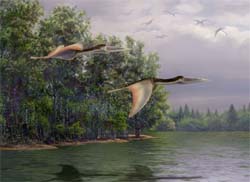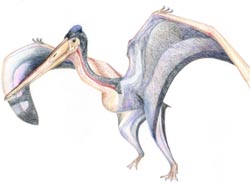
Reconstruction scheme of Nurhachius ignaciobritoi (image by Zhang Zongda)

The fresh discoveries on pterosaurs by CAS researchers from the Jehol Fauna in the northeast China's Liaoning Province might shed new light on the studies of the extinct flying reptile that once ruled the skies for 160 million years in the Jurassic and Cretaceous periods. They make scientists to speculate that the western backwater of Liaoning could be one of the origin centers, from which the diverse populations of pterosaurs first made debut hundreds of thousand years ago.
In cooperation with their Brazilian co-workers, Prof. WANG Xiaolin and ZHOU Zhonghe from the CAS Institute of Vertebrate Paleontology and Paleoanthropology discovered two new species of pterosaurs from the Yixian Formation and Jiufotang Formation respectively. The scientists believe that they lived about 125-120 million years ago in the Cretaceous period and belonged to groups previously found only in Europe. It is the first discovery of these kinds beyond the boundaries of the continental Europe over the past two centuries. The work was reported in the October 6 issue of the prestigious journal
Nature.
The two new species are named
Feilongus youngi and
Nurhachius ignaciobritoi. Anatomically, the former features two independent crests and a protruding upper jaw while the latter has teeth topped by triangular crowns and a long nasoantorbital cavity. Etymologically, feilongus comes from the Chinese term
feilong, meaning a flying dragon and youngi is taken in honor of the late Chinese paleontologist YANG Zhongjian (Young C. C., 1897-1979), who had described the first pterosaur fossil unearthed in China. Nurhachius comes from a Manchurian hero in Chinese history, Nurhachi (1559-1626) who was the founder of China's last feudal dynasty while Liaoning Province was his homeland and main living theatre; ignaciobritoi is introduced to honor the late Brazilian scholar Ignacio M. Brito, a precursor in the paleontological studies of Brazil. Both equipped with a wingspan reaching somewhere between 2.4-2.5 meters, the two were large-sized flying reptile species living in mid- or late period of the early Cretaceous with relatively advanced anatomic features.
The analyses of the Sino-Brazilian research team revealed that the morphological traits of the two new species present a stunning taxonomic diversity between the flying reptile populations once living at the opposite ends of the Euro-Asian continent in the land-based Cretaceous ecosystems which is beyond the conventional understanding of the pterosaur's evolutionary course. In addition, more interestingly, it also offers a chance to scientists for examining the interaction and competition between primitive birds and pterosaurs, indicating that the avian populations dominated hinterland regions whereas pterosaurs mainly lived on some coastal areas of the Mesozoic continents.
Long before the birds and bats took wing, the skies were ruled by pterosaurs, the flying reptiles that were the Earth's first flying vertebrates. They arose some 230 million years ago and thrived for 160 million years in a row as the ruler of skies until going extinct at the end of the Cretaceous period. The pterosaur's light and hollow bones aided its flight when making a convenient takeoff. But their fragility also made fossilization difficult - best achievable in the soft ooze of the seafloor or lake bed like those within Mesozoic basins well-developed in today's western Liaoning Province.
"The pterosaur is noted for its once flourishing and diverse populations due to its well-developed adaptation to various environments as a successful branch of the giant 'lizard' family," notes Prof. Wang Xiaolin. "However, its fossilized remains are far less than those left by common dinosaurs in number, becoming prized rarities in the eyes of fossil collectors. This is because of its fragile skeleton and living style to keep flying in the sky as birds do."
Since the first discovery about 200 years ago in Europe, so far some 130 species of pterosaurs have been recorded in all continental landmasses on the Earth, including 13 pterosaur species brought to light from the Jehol Biota, which is believed the evolutionary cradle of many creatures either alive today or extinct already and the most affluent bonanza in terms of yielding the flying reptile specimens.
Based on detailed research into the phylogenetic relationship of 40 pterosaur taxa worldwide, the scientists discovered the close affinity between the two new species and their European cousins, showing intimate exchange between the two pterosaur assemblages at the eastern and western tips of the Euro-Asian Landmass.
They further speculate that the Jehol Fauna should have been one of the phylogenetic origins of the Cretaceous pterosaurs and one of main worldwide hubs in the two-way migration. From there, many new species originating from the Jehol Fauna went to other places at all directions of the world.
"The discovery leads to an unexpected revelation of a new combinatorial pattern among the pterosaur populations in the Jehol Fauna," says Prof. Zhou Zhonghe. "This shows that the flying reptile has its own unique evolutionary history full of turns and twists. So, the new discovery and others from the Jehol Fauna may be the key to demystify the puzzles in the pterosaur's history in the Cretaceous," he concludes.








